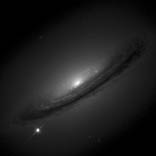What is Your Cosmic Connection to the Elements?
We see how stars produce many of the elements on the periodic table. Solar winds, planetary nebulae, and occasional novae liberate a fraction of these elements - too little, though, to account for the amounts we see in the Universe today. Is there another way these elements are made or dispersed? And what produces the remaining elements on the periodic table?
Look again at what happens in large stars. As red supergiants, they fuse many elements, finally producing iron in their cores. Iron is the end of the line for fusion. Thus, when the core begins to fill with iron, the energy production decreases. With the drop in energy, there is no longer enough energy to counteract the pull of gravity. The star begins to collapse. The collapse causes a rise in the core temperature to over 100 billion Kelvin and smashes iron's electrons and protons together to form neutrons. Because of their smaller size, the neutrons can pack much closer together than atoms, and for about 1 second they fall very fast toward the center of the star. After the fall, they smash into each other and stop suddenly. This sudden stop causes the neutrons to violently recoil. As a result, an explosive shock wave travels out from the core. As it travels from the core, the shock wave heats and accelerates the surrounding layers. In addition, neutrinos (elementary particles with very little mass) arise from the formation of the neutrons. The energy from the neutrinos causes the majority of the star's mass to be blown off into space, in what is called a supernova. Astronomers refer to this as a Type II supernova.
 |
| Figure 5: Supernovae can outshine their host galaxies. Here SN 1994D shines brightly at the edge of its host galaxy, NGC 4526. |
Supernovae often release enough energy that they shine brighter than an entire galaxy, for a brief amount of time. The explosion scatters elements made within the star far out into space. Supernovae are one of the important ways these elements are dispersed into the Universe.
As it moves through the original onion layers of the star (Figure 3), the shock wave also modifies the composition of the layers (particularly the C, Ne, O, and Si layers) , through explosive nucleosynthesis. This contributes to the production of elements from Si to Ni, with many elements below iron being made from the Si shell.
The tremendous force of the supernova explosion also violently smashes material together in the outer layers of the star before it is driven off into space. Before it is expelled, this material is heated to incredible temperatures by the power of the supernova explosion, and undergoes a rapid capture of neutrons. This rapid neutron capture transforms elements into heavy isotopes, which decay into heavy elements. In seconds or less, many new elements heavier than iron are created. Some of the elements produced through this process are the same as those made in the star, while others come solely from the supernova process. Among the elements made only from supernovae explosions are iodine, xenon, gold, and most of the naturally occurring radioactive elements.




